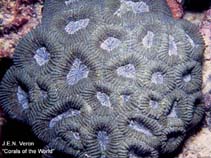Mussismilia hispida (Verrill, 1901)
Warning: DOMDocument::load(): SSL operation failed with code 1. OpenSSL Error messages: error:140770FC:SSL routines:SSL23_GET_SERVER_HELLO:unknown protocol in C:\Apache24\htdocs\includes\SpeciesSummary.lib.php on line 1236
Warning: DOMDocument::load(): Failed to enable crypto in C:\Apache24\htdocs\includes\SpeciesSummary.lib.php on line 1236
Warning: DOMDocument::load(https://sealifebase.nrm.se/webservice/AquaMaps/getAMap.php?genus=Mussismilia&species=hispida): failed to open stream: operation failed in C:\Apache24\htdocs\includes\SpeciesSummary.lib.php on line 1236
Warning: DOMDocument::load(): I/O warning : failed to load external entity "https://sealifebase.nrm.se/webservice/AquaMaps/getAMap.php?genus=Mussismilia&species=hispida" in C:\Apache24\htdocs\includes\SpeciesSummary.lib.php on line 1236
Classification / Names Common names | Synonyms | CoL | ITIS | WoRMS
| Scleractinia | Faviidae
Environment: milieu / climate zone / depth range / distribution range Ecologie
Rifbewoner; diepteverspreiding 0 - 30 m (Ref. 848). Tropical; 1°S - 25°S, 45°W - 37°W (Ref. 848)
Verspreiding Landen | FAO regio's | Ecosystems | Voorkomen | Introducties
Southwest Atlantic: Brazil.
Length at first maturity / Size / Gewicht / Leeftijd
Maturity: Lm ? range ? - ? cm
Korte beschrijving Morfologie
Formation: massive, less than 0.5 m across, usually flattened. Corallites: rounded, with thick walls, 10 to 15 mm in diameter. Septa: rounded, bead-like dentations only in living colonies. Color: browns and grays; corallite walls and centers often differently colored, commonly with radial stripes (Ref. 848).
Zooxanthellate (Ref. 121684). Occurs in shallow depths, tolerant of turbid environments (Ref. 848). On rocky reef (Ref. 121684).
Life cycle and mating behavior Geslachtsrijpheid | Voortplanting | Kuitschieten | Eieren | Fecundity | Larven
Members of the class Anthozoa are either gonochoric or hermaphroditic. Mature gametes are shed into the coelenteron and spawned through the mouth. Life cycle: The zygote develops into a planktonic planula larva. Metamorphosis begins with early morphogenesis of tentacles, septa and pharynx before larval settlement on the aboral end.
Voornaamste referentie
Referenties | Coördinator | Medewerkers
Bisby, F.A., M.A. Ruggiero, K.L. Wilson, M. Cachuela-Palacio, S.W. Kimani, Y.R. Roskov, A. Soulier-Perkins and J. van Hertum. 2005. (Ref. 19)
Status op de Rode Lijst van het IUCN (Ref. 130435)
Kwetsbaar, zie IUCN Rode Lijst (VU) ; Date assessed: 29 July 2021
Status bij CITES (Ref. 108899)
Appendix II: International trade monitored
CMS (Ref. 116361)
Not Evaluated
Gevaarlijk voor mensen
Gebruik door de mens
| FishSource |
Tools
Meer informatie
Populaire namen
Synoniemen
Predators
Voortplanting
Geslachtsrijpheid
Kuitschieten
Fecundity
Eieren
Ontwikkeling van de eieren
Synoniemen
Predators
Voortplanting
Geslachtsrijpheid
Kuitschieten
Fecundity
Eieren
Ontwikkeling van de eieren
Internet-bronnen
BHL | BOLD Systems | CISTI | DiscoverLife | FAO(Publication : search) | Fishipedia | GenBank (genoom, nucleotide) | GloBI | Gomexsi | Google Books | Google Scholar | Google | PubMed | Hexacorallians of the World | Tree of Life | Wikipedia (ga naar, zoek) | Zoological Record
Estimates based on models
Preferred temperature
(Ref. 115969): 24.4 - 27.6, mean 26.8 (based on 123 cells).
Prijsklasse
(Ref. 80766):
Unknown.



